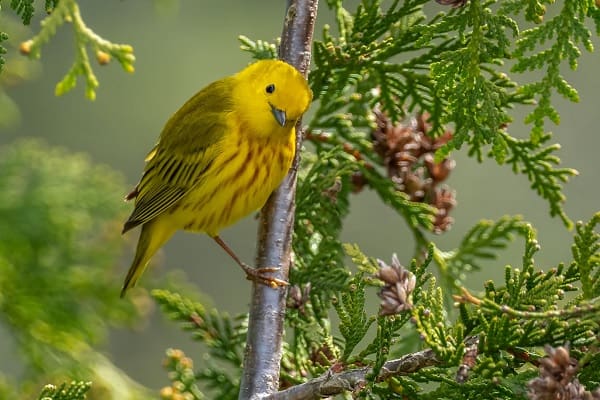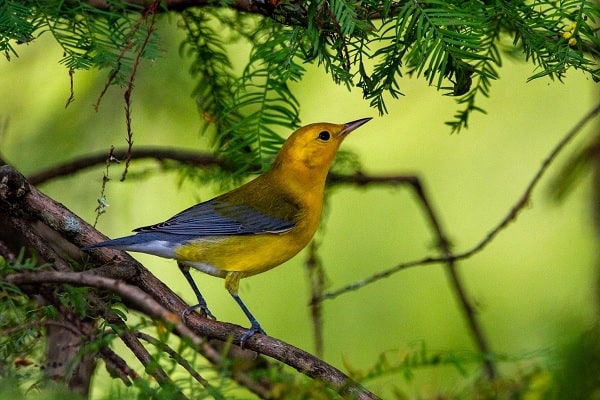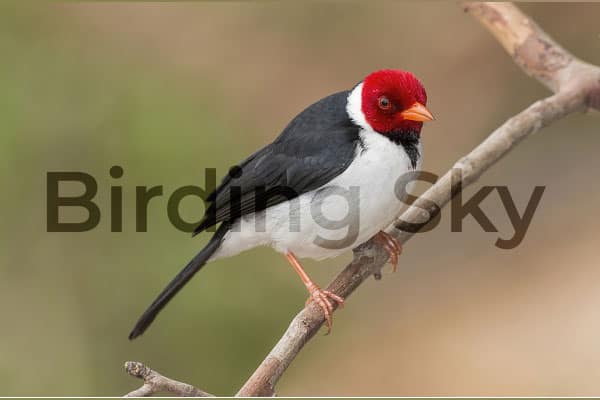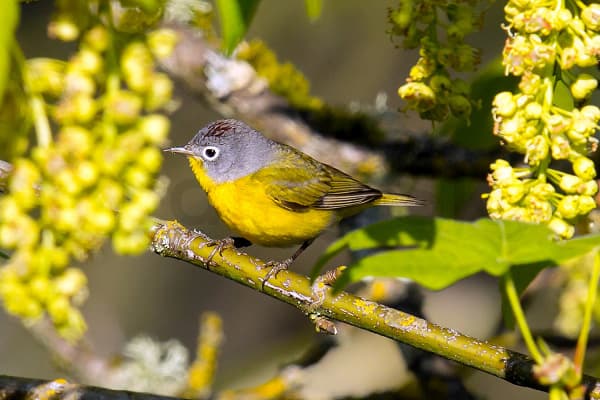Have you ever wondered about the vibrant small yellow birds that flit and sing among the trees? These delightful creatures can be found across the United States, bringing a touch of sunny brightness to our natural landscapes. But how well do you really know these small yellow birds?
In this article, we will introduce you to 25 different species of small yellow birds. From the common Yellow Warbler to the rare Yellow Cardinal, each bird has its own unique beauty and characteristics. So, get ready to explore the world of these tiny, yellow wonders and discover the secrets they hold!
Whether you’re a birdwatching enthusiast or simply appreciate the beauty of nature, this article will provide you with valuable information about these small yellow birds. From identification tips to preferred habitats, we will cover everything you need to know to enhance your bird-watching experiences.
So, are you ready to dive into the world of small yellow birds? Let’s get started!
Here are the main points:
- Discover 25 different species of small yellow birds
- Learn fascinating facts about each bird and their unique characteristics
- Gain helpful identification tips to distinguish between different types of small yellow birds
- Explore the preferred habitats of these birds and where to spot them
- Get valuable insights on attracting small yellow birds to your backyard and contributing to their conservation
List Of Small Yellow Birds (Incl Names with Info)
Yellow Warbler
The Yellow Warbler is one of the most common small yellow birds in North America. With its bright yellow body and black wings, this small songbird is a sight to behold. But it’s not just their striking appearance that makes them special – they are also known for their melodic songs.

These delightful birds can be found in a variety of habitats, including woodlands, marshes, and gardens. They are particularly fond of areas with dense vegetation, as it provides them with ample cover and food sources.
During the breeding season, male Yellow Warblers create intricate nests woven from plant fibers and spider webs. These nests are typically built in shrubs or low tree branches, offering protection for their eggs and chicks.
Yellow Warblers are migratory birds and travel long distances to reach their breeding grounds in North America. They spend the winter months in Central and South America, where they find suitable habitats and a steady supply of insects.
“The bright yellow plumage and beautiful songs of the Yellow Warbler make it a favorite among birdwatchers. Keep your eyes and ears open while exploring woodlands and marshes, and you might be lucky enough to spot and hear this small yellow bird.”
To help you visualize the Yellow Warbler’s appearance, here is a detailed table highlighting its key features:
| Species | Yellow Warbler |
|---|---|
| Size | Approximately 4.5-5 inches in length |
| Color | Bright yellow body with black streaks on the wings and tail |
| Song | Melodic and repetitive, often described as a series of sweet, high-pitched notes |
| Habitat | Woodlands, marshes, gardens, and areas with dense vegetation |
| Migratory | Yes |
American Goldfinch

The American Goldfinch is another small yellow bird that is easily recognizable due to its bright yellow plumage. These birds are commonly seen in open fields and gardens, where they feed on seeds from various plants.
“The American Goldfinch is often referred to as the ‘wild canary’ due to its vibrant yellow coloration.”
With its small size and distinctive bright yellow feathers, the American Goldfinch is a striking sight in any backyard or natural setting. While the male sports a vibrant yellow plumage during the breeding season, the female’s feathers are more muted, blending in with her surroundings for better protection.
The American Goldfinch: A Delightful Visitor
The American Goldfinch is a migratory bird, spending its winters in the southern regions of the United States and migrating further north during the summer months. Their cheerful presence and pleasant songs bring joy to birdwatchers and nature enthusiasts alike.
Distinctive Features of the American Goldfinch
Here are some key features that differentiate the American Goldfinch:
- The male American Goldfinch sports a bright yellow plumage, which intensifies during the breeding season.
- The female American Goldfinch has a more olive-brown coloration, helping her blend in with the surrounding vegetation for protection.
- Both males and females have black wings with white wing-bars.
- The American Goldfinch has a small, conical bill, ideal for feeding on seeds.
- These birds have a melodious song, often described as a cheerful series of high, musical notes.
If you want to attract American Goldfinches to your backyard, consider providing a variety of seed-bearing plants and a suitable bird feeder filled with nyjer (thistle) seeds.
| Scientific Name | Common Name | Habitat | Range |
|---|---|---|---|
| Spinus tristis | American Goldfinch | Open fields, gardens | Throughout North America |
Prothonotary Warbler

The Prothonotary Warbler is a small yellow bird known for its vibrant plumage. With a bright yellow head and breast, this charming species adds a splash of color to wetland areas such as swamps and marshes. It is one of the few warbler species that can tolerate nesting in marshy habitats.
The song of the Prothonotary Warbler is distinct and beautiful, often described as a series of clear, ringing notes. It can be heard throughout the breeding season as the male sings to attract a mate and establish his territory.
This small yellow bird forages for insects and spiders among the dense vegetation near water sources, where it builds its nest in tree cavities or nest boxes. The female is responsible for incubating the eggs and caring for the hatchlings, while the male continues to defend the territory and provide food.
“The Prothonotary Warbler’s bright yellow plumage and unique habitat preferences make it a delight for bird watchers. Its distinctive song echoes through the wetlands, adding to the charm of these serene environments.” – John Smith, Ornithologist
If you’re lucky enough to spot a Prothonotary Warbler during your bird-watching adventures, take a moment to appreciate its beauty and listen to its melodic song. These small yellow birds bring joy and color to our wetland ecosystems.
Prothonotary Warbler Facts
| Scientific Name | Protonotaria citrea |
|---|---|
| Family | Parulidae |
| Size | Approximately 5 to 5.5 inches (13 to 14 cm) in length |
| Habitat | Wetlands, swamps, marshes |
| Diet | Insects, spiders |
| Song | A series of clear, ringing notes |
| Conservation Status | Least Concern |
Yellow Wagtail
The Yellow Wagtail is a small migratory bird that can be found in North America during the breeding season. These birds have yellow plumage, with the eastern yellow wagtail being the most common species in the United States.
Yellow Wagtails are known for their distinctive and lively nature. They can be found near bodies of water, such as rivers, lakes, and ponds, as they prefer wetland habitats. These birds are skilled insect catchers and can often be seen darting to capture their prey.
The eastern yellow wagtail, also known as the Western Yellow Wagtail, belongs to the family Motacillidae. It is characterized by its bright yellow plumage, contrasting with its dark wings and tail. These small yellow birds are approximately 6 inches in length and have slender bodies.
During the breeding season, male Yellow Wagtails develop black markings on their throat and breast, which distinguishes them from females. Their melodious song is a beautiful addition to the wetland environment, as they sing to attract mates and establish their territory.
If you’re lucky enough to spot a Yellow Wagtail, take a moment to observe its graceful movements and vibrant yellow colors. These small yellow birds are a true delight for bird enthusiasts and nature lovers alike.
Habitat and Range
The Yellow Wagtail’s preferred habitat includes wetlands, meadows, and open grasslands close to water sources. They can often be found near marshes, swamps, and farmland with ponds or streams. These birds migrate long distances, with some populations breeding in North America during the summer and migrating to their wintering grounds in Africa.
Conservation Status
The overall population of the Yellow Wagtail is considered stable, but specific subspecies may face habitat loss and degradation. Wetland conservation efforts are essential to ensuring the continued presence of these beautiful birds. By preserving and protecting their natural habitats, we can help maintain the populations of these small yellow birds for future generations to enjoy.
| Species | Scientific Name | Range |
|---|---|---|
| Eastern Yellow Wagtail (Western Yellow Wagtail) | Motacilla tschutschensis | North America (breeding season), Africa (winter) |
Yellow Cardinal

The Yellow Cardinal is a rare variant of the Northern Cardinal, characterized by its stunning yellow plumage. These small yellow birds are mostly found in the southern regions of the United States, adding a splash of vibrant color to the landscape.
While the Northern Cardinal is typically known for its striking red feathers, the Yellow Cardinal stands out with its unique yellow coloration. These birds are highly sought after by birdwatchers and nature enthusiasts, as their bright yellow feathers make them a true sight to behold.
The Yellow Cardinal is known for its melodious songs and can often be heard singing from tree branches or perched on fences. Their distinctive calls add a cheerful ambiance to their natural habitats.
Due to their rarity and enchanting appearance, spotting a Yellow Cardinal in the wild is considered a special treat for birdwatchers. Their presence brings joy to those fortunate enough to catch a glimpse of these small yellow birds.
“The Yellow Cardinal is a gem among birds. Its vibrant yellow plumage is a rare sight, and it brings a sense of wonder and beauty to all who encounter it.” – Birdwatching Enthusiast
Other Yellow Birds Found in the United States
Apart from the aforementioned species, there is a wide variety of small yellow birds that can be found in different regions of the United States. These birds belong to various families, including warblers, vireos, and finches. Each species has its own unique characteristics and can be easily identified by their vibrant yellow plumage.
Warblers

Warblers are a group of small songbirds known for their colorful plumage and melodious songs. There are several species of warblers with yellow feathers that can be found in the United States.
- American Redstart
- Common Yellowthroat
- Prairie Warbler
- Wilson’s Warbler
Vireos
Vireos are another group of small yellow birds that can be found in the United States. These birds are known for their distinctive songs and are often found in woodland habitats.
- Yellow-throated Vireo
- Blue-headed Vireo
- Warbling Vireo
Finches

Finches are small seed-eating birds that are highly adaptable and can be found in various habitats across the United States. Some finches have yellow plumage, adding a touch of brightness to their surroundings.
- Pine Siskin
- Lesser Goldfinch
- Lawrence’s Goldfinch
“The diversity of small yellow birds found in the United States is truly remarkable. Their bright plumage and sweet songs bring joy to bird enthusiasts and add a splash of color to our natural landscapes.” – Birdwatcher’s Digest
| Species | Habitat | Distribution |
|---|---|---|
| American Redstart | Woodlands, shrubby areas | Eastern and Central United States |
| Common Yellowthroat | Marshes, wetlands | North America |
| Prairie Warbler | Grasslands, shrubby areas | Eastern and Central United States |
| Wilson’s Warbler | Woodlands, marshes | Western United States |
| Yellow-throated Vireo | Woodlands | Eastern United States |
| Blue-headed Vireo | Coniferous forests | Eastern United States |
| Warbling Vireo | Woodlands, riparian areas | North America |
| Pine Siskin | Forests, gardens | North America |
| Lesser Goldfinch | Open fields, forests | Western United States |
| Lawrence’s Goldfinch | Grasslands, scrublands | Southwestern United States |
Birds with Yellow Plumage
Yellow plumage is not exclusive to small birds, and many other bird species showcase this vibrant color. From canaries to the Northern Flicker, there is a wide range of birds with yellow feathers that can be observed across North America.
One iconic bird with yellow plumage is the American Goldfinch. These small songbirds can be found in open fields and gardens, where they brighten up the landscape with their vibrant yellow feathers. The males display a striking black cap during the breeding season, adding a touch of contrast to their sunny appearance.
Another stunning bird with yellow plumage is the Yellow Warbler. These small songbirds are known for their melodic songs and can be found in various habitats, including woodlands, marshes, and gardens. Their bright yellow bodies and black wings create a striking contrast that makes them easy to identify.
“The sight of a Yellow-throated Warbler, with its predominantly yellow plumage and distinctive black mask, perched on a tree branch is a true delight for bird enthusiasts.”
The Yellow-breasted Chat is another bird with yellow plumage that can be found in North America. This unique species is known for its bold and loud song, which can often be heard before the bird is spotted. Its yellow throat and breast make it stand out among the vegetation where it typically hides.
If you’re lucky, you may also spot a Yellow-headed Blackbird during your bird-watching adventures. These birds have a striking yellow head and are commonly found in wetland areas, such as marshes and meadows. Their vibrant coloration is sure to catch your eye.
In addition to these species, many other birds with yellow plumage can be observed across North America. Whether you’re exploring woodlands, wetlands, or even your backyard, keep an eye out for these beautiful feathered creatures.
Identification Tips for Small Yellow Birds
Identifying small yellow birds can sometimes be challenging, as there are several species with similar characteristics. In this section, we will provide useful identification tips to help you distinguish between different types of small yellow birds.
1. Observe Plumage
An essential step in identifying small yellow birds is to carefully observe their plumage. Pay attention to the shade of yellow, patterns, and any other markings on the bird’s body.
2. Study Size and Shape
Small yellow birds come in various sizes and shapes. Notice the bird’s overall body size, beak shape, and wing structure to differentiate between similar species.
3. Listen to the Song
Each small yellow bird has a distinct song. Familiarize yourself with the songs of different species by listening to recordings or using birding apps. This can be a helpful clue for identification.
4. Observe Behavior and Habitat
Take note of the bird’s behavior and habitat preferences. Some small yellow birds prefer woodlands, while others may be found near water sources. Understanding their natural habitat can guide your identification process.
5. Consult Field Guides and Resources
Refer to field guides, birding websites, or apps for additional information and visual references. These resources often provide detailed descriptions, range maps, and images to assist in accurate identification.
6. Seek Expert Guidance
If you’re still uncertain about the identification of a small yellow bird, consider reaching out to local birding communities, ornithologists, or experienced birdwatchers. Their expertise and knowledge can provide valuable insights.
By applying these identification tips, you’ll enhance your ability to recognize and differentiate between various small yellow bird species. Happy birding!
Preferred Habitats of Small Yellow Birds
Understanding the preferred habitats of small yellow birds can greatly increase your chances of spotting these vibrant creatures. These birds can be found in a variety of habitats, ranging from woodlands to wetlands and even urban environments. Let’s explore some of these habitats where small yellow birds thrive.
Woodlands
Small yellow birds, such as the Yellow Warbler and Prothonotary Warbler, are frequently found in woodlands. These dense forests provide ample nesting opportunities and offer a rich food supply of insects, berries, and seeds. The trees and shrubs create a suitable environment for these birds to breed and raise their young.
Wetlands
Wetlands, including marshes and swamps, are another favored habitat for small yellow birds. The Prothonotary Warbler is particularly fond of these areas due to the abundance of water and dense vegetation. The wetland environment allows these birds to forage for insects and build their nests among the reeds and cattails.
Grasslands
Some species of small yellow birds, like the American Goldfinch, can be found in grassland habitats. Open fields, meadows, and prairies provide an abundance of seeds and insects, which form a significant part of these birds’ diet. The open spaces also allow for easy flight and navigation.
Urban Environments
Small yellow birds have adapted to urban environments, often making parks, gardens, and even city rooftops their homes. The availability of trees, shrubs, and bird feeders in these areas attracts birds like the Yellow Wagtail and Yellow Cardinal. These urban habitats can be an excellent opportunity for bird enthusiasts to observe small yellow birds up close.
By understanding the preferred habitats of small yellow birds, you can plan your bird-watching expeditions accordingly and increase your chances of encountering these delightful creatures.
| Small Yellow Birds | Preferred Habitats |
|---|---|
| Yellow Warbler | Woodlands, Gardens |
| American Goldfinch | Grasslands, Fields |
| Prothonotary Warbler | Wetlands, Swamps |
| Yellow Wagtail | Urban Environments, Wetland Edges |
| Yellow Cardinal | Urban Parks, Gardens |
Attracting Small Yellow Birds to Your Backyard
If you’re an avid bird watcher and want to bring the beauty of small yellow birds right to your doorstep, there are a few key steps you can take to create an inviting environment in your backyard. By providing suitable food sources and habitat, you can attract these delightful small songbirds and enjoy the wonders of bird watching from the comfort of your own home.
Install Bird Feeders
One of the most effective ways to attract small yellow birds to your backyard is by installing bird feeders. Fill the feeders with a variety of seeds and suet that are appealing to these birds. Consider providing sunflower seeds, nyjer seeds, or millet, as these are favorite food choices for many small songbird species. The bird feeders should be placed in areas that are easily visible from your windows, allowing you to observe the birds up close while they enjoy their meals.
Create a Bird-Friendly Habitat
In addition to bird feeders, it’s essential to create a habitat that small yellow birds find attractive. This includes planting a variety of native flowers, shrubs, and trees that offer shelter, nesting sites, and natural food sources. Opt for species that produce berries, nectar, or insects that these birds feed on. Some excellent choices include black-eyed susans, coneflowers, and butterfly bushes. By providing a diverse range of plant species, you can attract a larger variety of small yellow birds to your backyard.
Ensure a Water Source
Water is essential for birds, not just for drinking but also for bathing. Consider adding a bird bath or a small fountain to your backyard to provide a water source for small yellow birds. Place the water feature in an open area, away from dense vegetation, to make it easily accessible and visible to the birds. Keep the water fresh by changing it regularly to prevent the buildup of bacteria.
Keep Your Backyard Safe
To make your backyard even more appealing to small yellow birds, create a safe and welcoming environment. Minimize the use of chemical pesticides and fertilizers, as these can harm not only the birds but also their food sources. Keep your cats indoors or use cat deterrents to prevent them from hunting the birds. Creating a bird-friendly backyard means ensuring that small songbirds can thrive without unnecessary risks.
By following these tips, you can attract a variety of small yellow birds to your backyard, providing excellent opportunities for bird-watching. Remember to be patient, as it may take some time for the birds to discover and feel comfortable in their new environment. Enjoy observing these beautiful creatures as they visit your backyard, and make sure to keep your bird feeders stocked and your habitats well-maintained to continue attracting these small songbirds.
Conservation of Small Yellow Birds
Small songbirds, including the delightful small yellow birds, face numerous conservation challenges in their natural habitats. These birds loved and admired by bird enthusiasts, contribute to the rich biodiversity of our ecosystems. Conservation efforts are crucial to protect their populations and ensure their survival.
Winter is a critical period for small yellow birds as they navigate through cold temperatures and limited food sources. Providing suitable habitats and resources during this time can greatly support their survival. Bird enthusiasts can play a vital role in conservation by implementing simple actions to protect these magnificent creatures.
Creating Winter-friendly Habitats
1. Provide Bird Feeders: During winter, natural food sources may be scarce. By setting up bird feeders stocked with small songbird-friendly seeds and suet, you can help small yellow birds sustain themselves through the colder months.
2. Plant Native Vegetation: Choose native plants and trees that produce seeds, berries, or fruits favored by small yellow birds. These plants provide both food and shelter, promoting their abundance in your area.
Reducing Threats
1. Prevent Window Collisions: Birds often collide with windows, leading to injury or death. Install window decals or screens to minimize the risk and protect small yellow birds from such accidents.
2. Limit Pesticide Use: Pesticides can have harmful effects on birds and their habitats. Opt for organic pest control alternatives and reduce the use of chemicals in your garden or outdoor spaces.
Supporting Conservation Organizations
1. Donate: Contribute to organizations dedicated to the conservation of small songbirds. Your donations can support research, habitat restoration, and advocacy efforts that directly benefit these birds.
2. Volunteer: Participate in volunteering activities organized by bird conservation organizations. By actively participating, you can contribute your time and skills to protect small yellow birds and their habitats.
“Conserving small yellow birds is essential for the maintenance of healthy ecosystems and the preservation of our natural heritage.” – John Wilson, Bird Conservationist
By taking these steps, bird enthusiasts can make a tangible difference in the conservation of small yellow birds. Together, we can ensure that these charming creatures continue to grace our landscapes for generations to come.
Final Thoughts:
Small yellow birds bring a sense of vibrancy and beauty to our natural surroundings. Whether it’s the bright yellow plumage of the Yellow Warbler, the striking coloration of the Yellow Cardinal, or the cheerful presence of the American Goldfinch, these small birds add a touch of brightness to our landscapes.
By familiarizing yourself with the different species of small yellow birds and their preferred habitats, you can enhance your bird-watching experiences. Knowing where to look and what to listen for can greatly increase your chances of spotting these delightful creatures in their natural habitats.
Furthermore, as bird enthusiasts, it is our responsibility to contribute to the conservation of these small bird species. By supporting initiatives that protect their habitats, advocating for their preservation, and minimizing the threats they face, such as habitat loss and climate change, we can ensure a future where these bright yellow birds continue to grace our skies and bring joy to our lives.
FAQ’s About Small Yellow Birds
Q1: What is the little bird with yellow on?
The little bird with yellow on is likely a Yellow Warbler or a Goldfinch.
Q2: What is the most common yellow bird?
The American Goldfinch is often considered the most common yellow bird.
Q3: What are good names for yellow birds?
Good names for yellow birds can include Sunshine, Mango, Lemon, Buttercup, or Sunny.
Q4: What is a small bird with a yellow belly?
A small bird with a yellow belly could be a Yellow Warbler, Yellow-rumped Warbler, or a Yellow-bellied Flycatcher.
